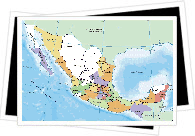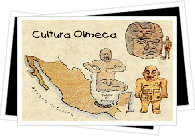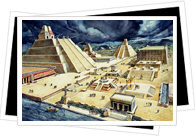
Despite its location in North America, the United Mexican States, or Mexico as it is better known is very much considered part of Latin America as it was conquered by the Spanish. With some 112 million inhabitants, it is the most populated Spanish speaking country and the eleventh most populous country in the world. In addition to Spanish, there are also 62 indigenous languages recognized in Mexico.

Archaeologists have found evidence of human activity in Mexico since 21,000BC, however, the first known society in Mexico were the Olmecs who lived close to present day Veracruz and flourished from 1200BC to 600BC. The Olmecs created giant head sculptures - some up to 3 metres high, a calendar system and also developed writing. Many Olmec influences were later adopted and adapted by the Maya who developed more sophisticated writing, studied astronomy and also worked with stone. The Maya dominated southern Mexico, Guatemala and Belize from 200BC until 900AD as well as some areas of Honduras and El Salvador.
The city of Teotihuacan, 40km northeast of present day Mexico City (D.F.), was the largest city in the Americas before the arrival of the Europeans. The empire of Teotihuacan lasted from 100BC to 700 or 800AD and the remains of their city are one of the most popular sights to visit in modern day Mexico. As the Maya empire collapsed, the Toltec's made their appearance in central Mexico around the 10th century, with their capital at Tula. They were military people with their influence extending over 1000km and their large stone soldier carvings can still be seen today at Tula.

The Aztecs (Mexica), were nomadic warriors who left their home in the north in the 1100-1200's and by 1430 had taken control of the Valley of Mexico, absorbing other tribes and groups into their own, stretching across into Guatemala. Tribes and groups who were not absorbed were used as human sacrifices according to Aztec religion. At the height of the Aztec empire, the Spanish dropped anchor in Mexico and 2 years later, in August 1521, the Aztec's surrendered to the invaders.
Mexico nowadays is well known for its spicy Latin foods, tropical beaches, Mariachis and its golden liquids - Tequila and beer. It is also one of the most bio-diverse countries in the world, ranking at number 5 and is home to more species of reptile than any other country in the world. 6% of Mexico is protected area, in biosphere reserves, national parks, marine parks, protected areas and ecological conservations zones. There are many locations in Mexico listed under UNESCO's world heritage site list which include the precolumbian towns of Chichen Itza, Teotihuacan, El Tajin and Uxmal, the ancient city of Calakmul and the historic towns of Mexico City, Puebla and Campeche to name just a few.
In Mexico there are three time zones: GMT-8, GMT-7 and GMT-6, all of which go forward one hour in the summer. Dry season (incorporating winter) is from November to June. Wet season is June to November with rainfall varying from torrential showers to short outbursts in the afternoon. Temperature and humidity differs according to location within the country.